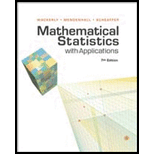
Concept explainers
Suppose that Y1, Y2, …, Yn is a random sample from a
where a and b do not depend on θ. Show that
Want to see the full answer?
Check out a sample textbook solution
Chapter 9 Solutions
Mathematical Statistics with Applications
- Recall that the general form of a logistic equation for a population is given by P(t)=c1+aebt , such that the initial population at time t=0 is P(0)=P0. Show algebraically that cP(t)P(t)=cP0P0ebt .arrow_forwardRepeat Example 5 when microphone A receives the sound 4 seconds before microphone B.arrow_forwardSuppose that X and Y have the following joint probability density function.f (x, y) = 3x 400 0 < x < 6, y > 0, x − 4 < y < x + 4 (a) Find E(XY). (b) Find the covariance between X and Y.arrow_forward
- Suppose that X and Y have the following joint probability density function. f(x,y) = 134² 0 0, x − 2 < y < x+2 (a) Find E(XY). (b) Find the covariance between X and Y.arrow_forwardLet X be a random variable with discrete pdf f(x) = x/8 if x = 1, 2, 5, and zero otherwise. Find: (a) E(X).arrow_forwardSuppose that X and Y have the following joint probability density function. f(x, y) = ₁34y, 0 0, x − 2 < y < x + 2 154, (a) Find E(XY). (b) Find the covariance between X and Y. Round your answer to 4 decimals. Round your answer to 4 decimals.arrow_forward
- Suppose that a sequence of mutually independent and identically distributed discrete random variables X₁, X2, X3,..., Xn has the following probability density function 0xe-0 x! f(x; 0) = 0, 7 for x = 0,1,2,... elsewhere Use the one-parameter regular exponential family definition to find the functions, h(x), c(0), w(0) and t(x).arrow_forwardSuppose that the following probability density function (pdf) for the random variable X: f(r:0) = f0(1+x)-(1+4) , 01 otherwise is a member of the one-parameter exponential family of the continuous type, then we have to choose the four functions p(0), k(x), S(x) and q(0) as follows: (A) p(@) = In 0, k(x) = In (1+ x), S(x) - -In (1+ x) and q(@) = 6 (B) p(@) = 0, k(x) = In (1 + x), S(x) = -In (1 + x) and q(0) = In 0 (C) p(@) = 0, k(x) = -In (1 + x), S(x) = In (1 + x) and q (@) = -In8 (D) p(8) = 6, k(x) =-In (1 + x), S(x) = -In (1+ x) and q(8) = In0 A Carrow_forwardIf the random variable Y has the following probability density function f(y) = {5 ,0 < y< 5 , (0,otherwise The probability that the root of the function g(x) = 4x² + 4yx + (y + 2) are real isarrow_forward
- Suppose that the random variables X and Y have the following joint probability density function. f(x, y) = ce-6x-2y, 0 < y < x. (a) Find the value of c. (b) Find P(X < Y < 2) ,arrow_forwardIs f(x) a legitimate probability mass function? E(1 – p)*='p =p+ (1 – p)p + (1 – p)²p+ • . · ² ? 1 | x=1arrow_forwardSuppose that Y₁, Y₂,..., Y is a random sample from a probability density function in the (one-parameter) exponential family so that [a(0)b(y)e-[c(Ⓒ)d(y)], a ≤ y ≤ b, f(y10) = 0, elsewhere, where a and b do not depend on 9. Show that Σd(Y) is sufficient for 0.arrow_forward
 Trigonometry (MindTap Course List)TrigonometryISBN:9781337278461Author:Ron LarsonPublisher:Cengage Learning
Trigonometry (MindTap Course List)TrigonometryISBN:9781337278461Author:Ron LarsonPublisher:Cengage Learning

